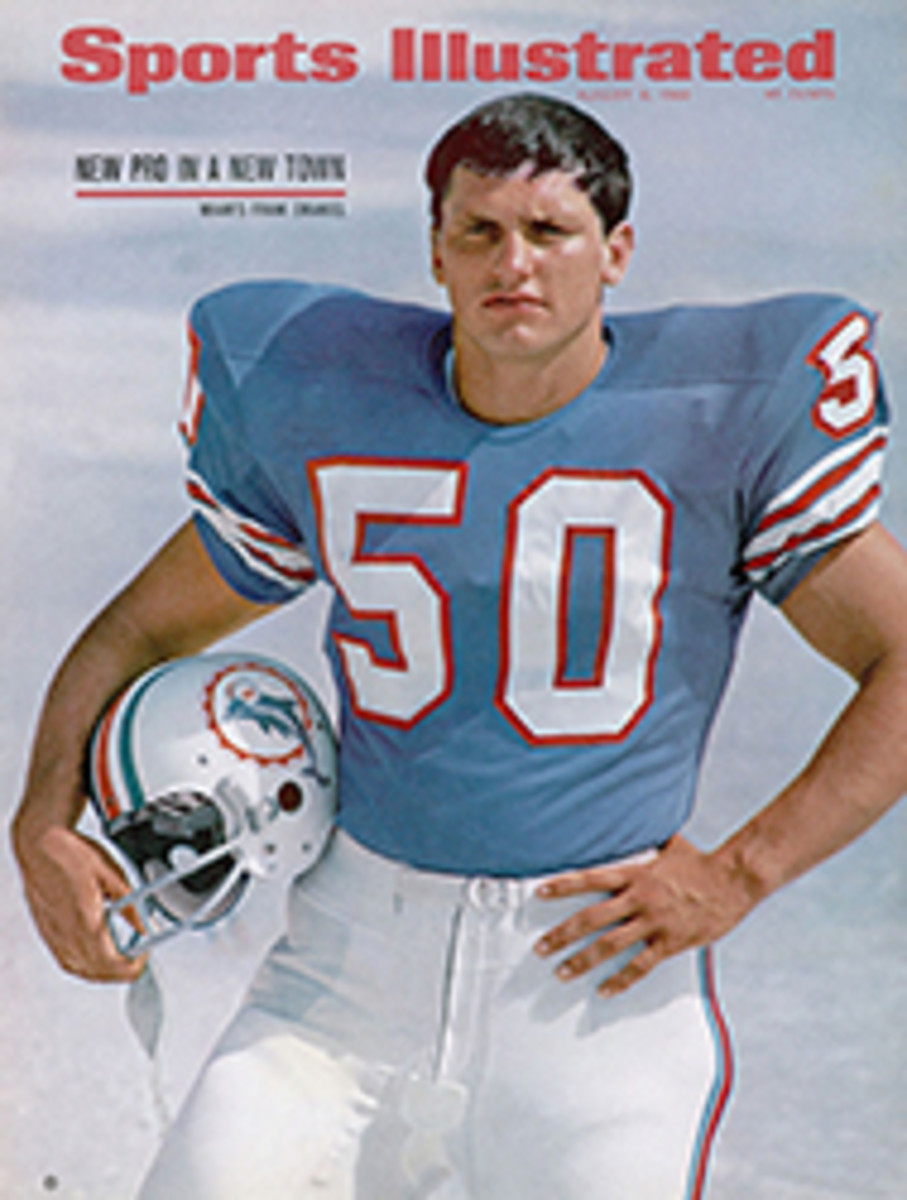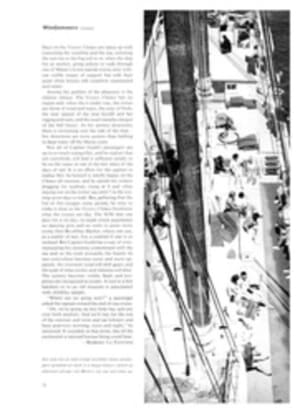
CAUGHT ON A BARBLESS HOOK
Between the 17th and 18th greens at the Cascades course in Hot Springs, Va. there is a pond, and near it is a sign that instructs: ALL FISH TO BE RELEASED UNHARMED. USE BARBLESS HOOKS ONLY. It is too bad the sign did not also demand solicitude on behalf of visiting ladies, for last week the British Curtis Cup team played the two holes in 20 over par, lost eight matches there and threw the cup to the rainbow trout.
It is not so much that the British really expected to beat the older, more experienced Americans, but with their pluck and youth, and pars on those final holes, they would have added to England's glories of the week by winning 10 to 8 instead of losing 13 to 5. And even as things were, pond and all, they did surprisingly well in this 34-year-old competition between the best women amateur golfers of the U.S. and Great Britain.
The Curtis Cup is not a cup at all. Appropriately, considering the number of American victories in the competition (10), it is a Paul Revere silver bowl. Only twice since 1932, when the prize was donated by two Boston spinsters, the Misses Harriot and Margaret Curtis, has Great Britain managed to win it.
The site of this year's matches, The Homestead, is a place where Miss Margaret would have felt at home and might well have lit up her usual after-dinner pipe. Set deep in the Allegheny Mountains, the hotel has retained the opulence and old-world ways it had as a 19th century spa. It opened in 1846 asserting that its mineral springs would cure gout, dysentery, jaundice, deafness and loss of voice. These claims have been watered down a bit, but little else has changed.
"It is not what I expected," one of the British Curtis Cuppers said. "It looks a bit like Gleneagles." Another took one long look and said, "It's Tara in Gone with the Wind."
The British arrived in Hot Springs seven days before the Americans and quickly became accustomed to the short, British-type course. The night before play began, Mrs. Dora Bolton, the British captain, said: "We may have been here too long. We could be too acclimated."
Only three of the British team had played in the Curtis Cup before. Angela Bonallack, an English amateur winner, was a veteran of five matches. The other two were Mrs. I. C. Robertson of Scotland and vivacious and voluble Susan Armitage, a 23-year-old hairdresser from the Midlands. "Whatever comes into her head, comes right out," said a member of the U.S. team. It is an endearing characteristic, and one that made her the most popular player at Hot Springs.
The remainder of the British might have been inexperienced, but they were a happy-go-lucky lot and young enough to be unimpressed by the fact that the American team members had won among them five U.S. and one British amateur championships.
There was 20-year-old Pamela Tredinnick, a sparky, blue-eyed part-time salesgirl in a London department store. A few months ago she and three golfing roommates rocked the Royal and Ancient by recording a song she describes as being about "chasing men." The lyrics begin: "We need four jolly bachelors, four handsome men indeed."
The record has not been released, because, as Pam says, "the R & A asked us to make some adjustments."
Another member of the team, 23-year-old Elizabeth Chadwick, works in a garage—spare parts department—in the north of England to pay for her golf. Then there is tiny Ita Burke, a travel agent for a Dublin firm and the only one of the British golfers to win two matches. When she was named to the team many British writers protested. They called for the immediate resignation of the four electors of the team but found that the electors had already retired. It has become customary for them to resign immediately after they name the Curtis Cup squad and long before the matches actually begin. No one can blame them.
The selection of the U.S. team is, at times, as controversial as that of the British eight. The United States Golf Association picks its players on "their records in competition, unquestionable amateur status and general ability to represent the country." Certainly golfing talent is of primary importance, but golf's traditions stem from an era of social grace and privilege, and women's golf seems to have retained this link with the past the longest of all. The USGA understandably will go to some lengths not to pick a woman for the Curtis Cup team who might do the monkey on the clubhouse buffet, but the ultraconservative women's committee has young U.S. golfers so concerned with their image that during the recent U.S. Women's Open one of the best of them thought it wise to go the ladies' room to smoke.
The 1966 American team was, as The Roanoke Times said quite grandly last week, composed of "the bronzed daughters of Uncle Sam—veterans all." Their average age was 30—as compared with 25 for the British—and all of them had played in at least one Curtis Cup before. Not long ago Anne Quast Welts, who has been a member of four U.S. teams, said: "It is harder to get off the Curtis Cup team than to get on it." Maybe so. It is a fact that U.S. teen-agers have spent the summer beating Curtis Cuppers—no cup team player has won a major championship since school let out.
On the other hand, only the dourest grouch would have complained about the selection of 46-year-old Helen Sigel Wilson for the U.S. squad. She had waited 16 years to step once again into one of the team's blue skirts, and she cried when the national anthem was played to open the matches. In some cases age before teen-age is laudable.
The U.S. team arrived at The Homestead the Sunday before the matches began. On Monday it was drilling shot after shot, hour after hour, down the Cascades' fairways in intense practice sessions overseen by its nonplaying captain, Mrs. Mark A. Porter.
Instructed to be careful with the press lest a chance remark prove to be impolitic, the team guarded its practice-round results like state secrets. Perhaps out of strategy, perhaps out of modesty, Mrs. Porter told a press conference Thursday that the best round by one of her players was an even-par 71. The truth, Lawyer David Welts later admitted, was that his wife had shot a 67 Thursday morning. Anne Welts blushed deeply. "Oh, it's so hard not to talk about it," she said. "It's two strokes better than I've ever shot in my life."
Friday morning there was a cold mist, and the bittersweet smell of wet pine came from the mountains. Mrs. Bolton pinned a bunch of heather to her blouse—the same heather she wore when she was captain of the team in 1956, the year the British last won—and led her crew of singers, salesgirls, hairdressers and garage employees down to the slaughter. U.S. Captain Porter countered by carefully counting the clubs in each of her player's bags and setting a good example with a nice noncontroversial smile.
But soon U.S. smiles faded. Each of the two days of play involved three foursome matches in the morning and six singles matches in the afternoon. Surprisingly, at the end of nine holes on Friday, the foursome matches were all even.
The pattern held until the 17th hole, where the top British pair of Bonallack and Armitage were 1 up on U.S. Champion Jean Ashley and her partner, Tish Preuss. There Susan, driving for the British, hit a tee shot that bounced toward the creek that runs along the right side of the fairway. The ball lodged in the bank, and only after the partners had put three gashes in it did the ball fly out. The U.S. won the hole with a par, and the match was again even.
Tish Preuss now had the honor. She stood on the 18th tee and hit a 4-wood within four feet of the pin. When Angela pulled the British tee shot into the woods on the left, the U.S. had won a big match. It was only the first one of the Curtis Cup, but the British collapse on the 17th and 18th holes had begun. Not one of the British players put her tee shot on the 18th green on Friday. Every one of them made a bogey or worse, losing point after point they might have won. The only victorious member of the British team that day was Ita Burke. She beat Mrs. Wilson—whom Pam Tredinnick was affectionately calling Granny—with a par 4 on the 17th hole. At nightfall the U.S. lead was 7-2.
The next day the British lost three more matches on the same two holes. In the morning Liz Chadwick and Ita Burke beat Anne Welts and Barbara McIntire 1 up, but the other two British teams were defeated at the 17th. At lunch the U.S. was ahead 9 to 3 and Pam Tredinnick said, "Well, we've got to win all the singles to halve the Cup." Mrs. Bolton told the team stoutly, "Go ahead, girls, go ahead. You have nothing to lose." But they had lost far too much already. Late Saturday afternoon an English woman was heard to mumble as another British ball headed for trouble on 17, "It's this welfare state. Everything is done for them. They never have to think any more for themselves."
But that was hardly fair. They had presented a stronger challenge than expected to the Americans, and the U.S. had responded by remaining composed when the pressure was on. If anything, the British had done too much thinking as they stood on 17 and 18 looking at that tranquil trout pond.
PHOTO
Britain's Belle Robertson loses match on 18.
PHOTO
Mountain climbing could not help Ita Burke, whose shot into this lie cost her a match at 17.

